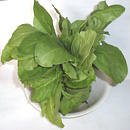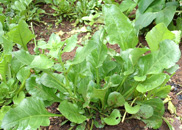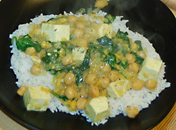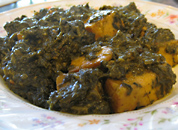Spinach nutrition facts
Spinach (Spinacia oleracea) is a wonderful green-leafy vegetable often recognized as one of the functional foods for its nutritional, antioxidants and anti-cancer constituents. Its tender, crispy, dark-green leaves are favorite ingredients of chefs all around the planet. Botanically it belongs to the Amaranthaceae family and its scientific name: Spinacia oleracea.
Spinacia plant grows about 1 foot in height. Although, it can be grown year round, fresh greens are best available just after the winter season in the Northern hemisphere from March through May and from September until November, in the South of the equatorial line.


At least, two varieties of spinach are cultivated for their edible leaves; Savoy type with dark-green crinkle (wrinkled) leaves and flat-leaf type with smooth surfaced leaves.
Health benefits of Spinach
- Spinach is store house for many phyto-nutrients that have health promotional and disease prevention properties.
- Very low in calories and fats (100 g of raw leaves provide just 23 calories). It contains a good amount of soluble dietary fiber; no wonder green spinach is one of the finest vegetable sources recommended in cholesterol controlling and weight reduction programs!
- Fresh 100 g of spinach contains about 25% of daily intake of iron; one of the richest among green leafy vegetables. Iron is an important trace element required by the body for red blood cell production and as a co-factor for oxidation-reduction enzyme, cytochrome-oxidase during the cellular metabolism.
- Fresh leaves are rich source of several vital anti-oxidant vitamins like vitamin A, vitamin C, and flavonoid poly phenolic antioxidants such as lutein, zea-xanthin and beta-carotene. Together these compounds help act as protective scavengers against oxygen-derived free radicals and reactive oxygen species (ROS) that play a healing role in aging and various disease processes.
- Zea-xanthin, an important dietary carotenoid, is selectively absorbed into the retinal macula lutea in the eyes where it is thought to provide antioxidant and protective light-filtering functions. It thus helps protect from "age-related macular related macular disease" (ARMD), especially in the elderly.
- In addition, vitamin A is required for maintaining healthy mucus membranes and skin and is essential for normal eye-sight. Consumption of natural vegetables and fruits rich in vitamin A and flavonoids also known to help the body protect from lung and oral cavity cancers.
- Spinach leaves are an excellent source of vitamin K. 100 g of fresh greens provides 402% of daily vitamin-K requirements. Vitamin K plays a vital role in strengthening the bone mass by promoting osteotrophic (bone building) activity in the bone. Additionally, it also has established role in patients with Alzheimer's disease by limiting neuronal damage in the brain.
- This green leafy vegetable also contains good amounts of many B-complex vitamins such as vitamin-B6(pyridoxine), thiamin (vitamin B-1), riboflavin, folates and niacin. Folates help prevent neural tube defects in the offspring.
- 100 g of farm fresh spinach has 47% of daily recommended levels of vitamin C. Vitamin C is a powerful antioxidant, which helps the body develop resistance against infectious agents and scavenge harmful oxygen-free radicals.
- Its leaves also contain a good amount of minerals like potassium, manganese, magnesium, copper and zinc. Potassium is an important component of cell and body fluids that helps controlling heart rate and blood pressure. Manganese and copper are used by the body as a co-factor for the antioxidant enzyme,superoxide dismutase. Copper is required in the production of red blood cells. Zinc is a co-factor in many enzymes that regulate growth and development, sperm generation, digestion and nucleic acid synthesis.
- It is also rich source of omega-3 fatty acids.
Regular consumption of spinach in the diet helps prevent osteoporosis (weakness of bones), iron-deficiency anaemia. Besides, it is believed to protect the body from cardiovascular diseases and cancers of colon and prostate.
Selection and storage
Spinach is best available during winter months. In the markets, buy fresh leaves featuring dark-green color, vitality and crispiness. Avoid those with dull/sunken leaves, yellow discoloration and spots.
Once at home, wash leaves thoroughly in clean running water and they should be rinsed in salt water for about 30 minutes in order to remove dust, insecticide residues.
Although it can be stored inside the refrigerator for up to a week, fresh leaves should be eaten at the earliest in order to get maximum nutrition benefits.
Preparation and serving methods
Wash leaves in cold water before use. Gently pat them dry using tissue or soft cloth. Trim away tough stems. Raw leaves can be either chopped, or used as they are in variety of recipes.
Here are some serving tips:
 |  |
| Spinach-rice with chickpeas and tofu. Photo courtesy: scottfeldestein | Palak-paneer. Thorughly cooked spinch leaves mashed, sauteed and mixed with cheese cubes. |
- Fresh spinach is eaten raw either in salad and vegetable burgers or as juice. Antioxidant properties may decrease significantly on steaming, frying and boiling for longer periods.
- Along with other vegetables, its leaves are used in the preparation of noodles, pie, pasta, rice preparations, and soups as well as in the preparation of baby-foods.
- In India and Pakistan, where it is popular as "palak", spinach features in variety of delicious cooking such as palak paneer (cheese cubes), aaloo-palak (with potato), fried rice, chicken and meat preparations.
- In India, and Bangladesh spinach is mixed with other seasonal greens like goosefoot (chenopodium album), fenugreek, mustard greens Malabar spinach (Basella alba), etc., to prepare saag which is eaten with unleavened bread (roti), and rice.
Safety profile
- Reheating of spinach left-over may cause conversion of nitrates into nitrites and nitrosamines by certain bacteria that thrive on pre-prepared nitrate-rich foods, such as spinach and many other green vegetables. These poisonous compounds may be harmful to health, especially in children.
- Phytates and dietary fiber present in the leaves may interfere with the bio-availability of iron, calcium and magnesium.
- Because of its high vitamin K content, patients taking anti-coagulants such as "warfarin" are encouraged to avoid spinach in their food since it interferes with drug metabolism.
- Spinach contains oxalic acid, a naturally-occurring substance found in some vegetables, which may crystallize as oxalate stones in the urinary tract in some people. People with known oxalate urinary tract stones are advised to avoid eating certain vegetables belonging to Amaranthaceae and Brassica family. Adequate intake of water is therefore advised to maintain normal urine output.
- It may also contain goitrogens, which may interfere with thyroid hormone production and can cause thyroxin hormone deficiency in individuals with thyroid dysfunction. (Medical Disclaimer).


No comments:
Post a Comment